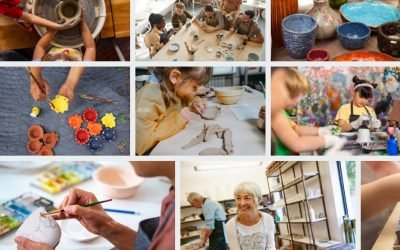Introduction to the Creative Challenges
AI in Media and Entertainment! Within the rapidly evolving landscape of media and entertainment, professionals encounter a myriad of creative challenges that significantly impact the production process. As the industry strives for innovation in storytelling, the pressure of tight deadlines and stringent budget constraints often overshadows the creative joy that initially draws artists to their craft. The expectation to deliver high-quality content in increasingly reduced timeframes can stifle the artistic expression that is vital for compelling narratives.
Moreover, these tightening schedules result in an environment where the focus shifts from creative exploration to mere survival mode, as artists scramble to meet deadlines. A lack of adequate time can impede collaborative efforts, leading to a disjointed vision for projects. This environment often results in a sense of burnout, both creatively and mentally, as artists find themselves trapped in a cycle of relentless productivity without the necessary space to breathe and innovate.
Furthermore, the financial realities that govern media and entertainment cannot be ignored. Many production teams operate within budget limits that can restrict creative possibilities, forcing them to make difficult compromises that may detract from the final product. These limitations can hinder the exploration of new technologies and artistic techniques that could otherwise elevate a project. As a result, many creatives find themselves grappling not only with deadlines but also with the constraints imposed by financial realities.
The intersection of these pressures leads to a challenging environment where achieving balance becomes paramount. Professionals must navigate these hurdles to harness their creativity effectively, ensuring that they can engage meaningfully with their audience. As the need for innovative storytelling persists, tools such as Autodesk and AI are emerging as potential solutions to alleviate some of these challenges, fostering a more sustainable approach to creativity in the industry.
The Rise of AI Media in Animation, VFX, and Game Studios
Over the past few years, the animation, visual effects (VFX), and game development industries have witnessed a significant transformation with the increasing adoption of artificial intelligence (AI). This evolution stems from the need for greater efficiency, enhanced creativity, and improved production capabilities. Traditionally, these sectors relied heavily on manual labor, a process that often proved time-consuming and costly. However, the integration of AI technologies, particularly in tools provided by platforms such as Autodesk, is redefining the landscape of creative productions.
One primary motivation behind the burgeoning utilization of AI within media and entertainment is the demand for faster workflows. AI algorithms can automate repetitive tasks, such as rigging, rendering, and texture mapping, which allows artists to focus on more complex and creative aspects of their projects. For example, Autodesk’s integration of AI-driven tools into their software suite facilitates the rapid prototyping of animations and VFX, enabling studios to meet tight deadlines without sacrificing quality.
Moreover, AI plays a pivotal role in enhancing creativity. Through sophisticated machine learning models, artists can harness AI to generate new ideas or optimize existing concepts. Techniques such as generative design and procedural generation empower creators to explore innovative solutions that may not have been conceivable through traditional methods. By analysing vast datasets, AI can help artists discern patterns and trends, providing them with insights that can enhance storytelling and visual engagement in animations and video games.
The growing reliance on AI in these studios is also a response to the increasing complexity of projects and the rising expectations of audiences. As the demand for high-quality content escalates, studios must constantly evolve. Therefore, employing Autodesk’s AI features not only streamlines production processes but also enhances artistic expression, which is essential in today’s competitive media environment.
Transforming Workflows with AI-Powered Tools
Autodesk leverages the power of artificial intelligence (AI) to transform workflows in the media and entertainment industry, significantly enhancing the efficiency and creativity of professionals in this field. The application of AI-driven tools allows for the automation of repetitious tasks, thus optimizing processes and liberating artists to concentrate more on the art of creative storytelling.
One of the notable tools from Autodesk is Autodesk Maya, which incorporates AI-enhanced features that streamline animation workflows. For instance, the predictive animation tool uses machine learning to anticipate key poses and in-betweens, enabling animators to achieve fluid character motions with minimal manual adjustments. This automation not only accelerates the animation process but reduces the potential for human error, allowing artists to focus on more intricate aspects of character development and narrative delivery.
In addition to animation, Autodesk’s 3ds Max offers powerful modeling capabilities that are augmented by AI. The software’s procedural modeling functions use intelligent algorithms that can generate complex assets with minimal input from the user. This capability allows artists to create intricate designs and structures at a faster pace, enhancing their creative output without compromising quality.
The rendering process, often one of the most time-consuming aspects of production, also benefits from Autodesk’s AI integration. Tools such as Arnold Renderer, which is included in many Autodesk products, employ AI techniques to optimize rendering times and improve image quality. By utilizing AI to automatically adjust settings based on scene complexity and lighting, artists can achieve superior results while spending less time on post-production tasks.
Overall, Autodesk’s AI-powered tools represent a significant step forward in the media and entertainment industry. They not only automate mundane tasks but also enhance the overall creative process, enabling artists to explore innovative ideas and elevate storytelling to new heights.
Enhancing Artistic Potential through AI Media
The integration of AI technologies, specifically Autodesk AI, has revolutionized the media and entertainment industry, enabling artists to unlock new levels of creativity. Historically, artists faced technical barriers that often hindered their creative expression. However, the emerging capabilities offered by AI have changed this narrative, allowing them to focus more on the artistic aspect of their work rather than the technical intricacies.
Autodesk AI tools provide users with advanced algorithms that streamline the creative process. For instance, generative design in 3D modeling allows artists to explore and create a multitude of design variations easily, thereby augmenting their artistic potential. This technology not only saves time but also encourages experimentation, enabling artists to push their boundaries further than they imagined. As a result, the creative process becomes more fluid, transforming ideas into tangible outcomes with greater efficiency.
Case studies have emerged demonstrating the profound impact of AI on artistic practices. For example, renowned filmmaker Kittie P. utilized Autodesk’s AI features in her recent project, which included intricate CGI elements. She reported that the AI tools allowed her team to generate complex visual effects that would have been incredibly time-consuming using traditional methods. Kittie emphasized how this technology not only enhanced the quality of the visuals but also enabled her creative team to experiment with concepts that they would not have dared explore otherwise.
Another example includes an artist named Max L., who has incorporated Autodesk AI in his painting techniques. By using AI to analyze color patterns and styles, he developed a unique artistic approach that combines traditional painting with digital enhancements. Max stated that AI functions as a creative collaborator, providing insights that prompt him to take his work in new directions.
Overall, Autodesk AI serves as a powerful companion, helping artists break through technical barriers and reimagining the artistic landscape in media and entertainment. This synergy fosters an environment where creativity thrives, allowing artists to focus on what they do best: creating.
Navigating the Balance Between Creativity and Technology
The intersection of creativity and technology has always been a point of contention, especially within the realms of media and entertainment. The introduction of advanced tools like Autodesk AI has significantly enriched the creative landscape, yet it simultaneously raises critical questions about the preservation of artistic integrity. As artists and creators embrace these evolving technologies, it is essential to navigate the balance between leveraging artificial intelligence and maintaining the essential human element of artistic expression.
Autodesk AI provides an array of tools designed to enhance the creative process, allowing artists to automate mundane tasks, thereby freeing them to focus on more complex elements of their projects. However, this shift can create a tension where artists may feel their unique vision is overshadowed by algorithmic processes. Critics argue that as AI becomes increasingly involved in the creative process, the risk of homogenizing artistic outputs rises, leading to a potential loss of individual style and voice.
Nevertheless, many industry professionals advocate for viewing technology, including Autodesk AI, as a collaborative partner rather than a replacement. By employing AI as an assistant, artists can harness its capabilities to push the boundaries of their creativity. This perspective emphasizes that technology should serve as a facilitator that enhances human ingenuity rather than a substitute that diminishes it. By integrating AI thoughtfully, creators can explore new dimensions in their work, allowing for fresh ideas and innovative storytelling while retaining their distinct artistic fingerprints.
Ultimately, a harmonious relationship between creativity and technology is achievable. By embracing the strengths of Autodesk AI in the media and entertainment sector while fostering the human touch inherent in artistic endeavors, a successful balance can be struck. This partnership paves the way for a future where both AI and human creativity flourish together, creating diverse and richly textured artistic expressions.
The Future of AI Media and Entertainment
The media and entertainment industry is undergoing a transformative phase driven by advancements in artificial intelligence. As studios increasingly integrate Autodesk AI tools into their creative processes, we can anticipate numerous innovations that will reshape the landscape of content creation. The advent of sophisticated AI technologies has the potential to streamline production workflows, enhance storytelling, and offer unprecedented personalization to viewers.
One of the most promising trends is the rise of AI-generated content. Tools powered by Autodesk AI can analyze vast datasets to create compelling narratives, generate realistic animations, and even compose music tailored to specific audience preferences. This not only accelerates the creative process but also allows for more experimentation, pushing the boundaries of traditional storytelling. As AI continues to evolve, we can expect studios to utilize these advanced systems for scriptwriting, editing, and even character development, opening up new avenues for creativity.
Moreover, the integration of AI in post-production processes will likely lead to significant advancements in visual effects and sound design. With Autodesk’s capabilities, filmmakers can achieve higher levels of realism with reduced time and resource investments. By automating routine tasks, creative teams can focus on higher-level decision-making and artistic vision, ensuring that the final product resonates with audiences on deeper emotional levels.
In addition to content creation, AI technology will influence audience engagement strategies. Predictive analytics can help studios understand viewer preferences and trends, enabling tailored marketing strategies and targeted content delivery. As viewers increasingly demand personalized experiences, leveraging Autodesk AI will be essential for studios to meet these expectations effectively.
Overall, the future of media and entertainment, bolstered by Autodesk AI, holds exciting possibilities. To stay competitive, studios must embrace these technological advancements, adapt their workflows, and prioritize innovation, paving the way for a new era of storytelling that resonates with diverse audiences.
Building a Culture of Creativity in AI-Driven Environments
The integration of artificial intelligence (AI) and tools like Autodesk into media and entertainment has revolutionized how creative processes are approached. However, fostering a culture of creativity within these AI-driven environments is essential for maximizing artistic output while maintaining the enthusiasm of artists and creators. Organizations must actively promote a collaborative atmosphere where individuals feel empowered to explore innovative ideas and express their creativity.
To build a culture that encourages creativity, studios should implement strategies that prioritize teamwork and open communication. Regular brainstorming sessions can serve as a platform for artists and technologists to share ideas, challenge each other, and explore possibilities offered by Autodesk AI solutions. Ensuring that everyone’s voice is heard reinforces a sense of belonging and ownership, which in turn nurtures creativity. Moreover, creating cross-functional teams composed of diverse skill sets enables a more holistic approach to problem-solving and innovation.
Another essential aspect is providing ongoing training and resources that familiarize creative professionals with AI technologies. By including AI workshops and hands-on demonstrations, individuals will gain valuable experience and confidence in utilizing Autodesk tools. This knowledge helps reduce any apprehension surrounding AI, enabling creators to view technology as an ally rather than a competitor. Encouraging experimentation with AI applications allows artists to find unique ways to express their visions, driving engagement and enthusiasm in the creative process.
Furthermore, recognizing and celebrating every team member’s contributions fosters an environment where artistic passion thrives. Regular feedback sessions highlighting individual achievements and collaborative efforts can boost morale and inspire further creativity. Ultimately, building a culture that embraces both artistry and AI solutions is crucial for studios seeking to stay relevant and competitive in the dynamic landscape of the media and entertainment industry.
Training and Upskilling for an AI-Enhanced Future
As the landscape of media and entertainment continues to evolve with the integration of Autodesk AI technologies, it is crucial for professionals in the industry to prioritize ongoing education and skill development. The rapid advancements in artificial intelligence have transformed the creative processes in various aspects of entertainment, including animation, visual effects, and game design. Consequently, artists and creators must equip themselves with the necessary knowledge and skills to effectively harness the capabilities of AI tools.
Several training programs and workshops are now available, providing invaluable resources for industry professionals to stay relevant in this AI-driven environment. Institutions and organizations, including Autodesk itself, offer a range of courses specifically designed to help users deepen their understanding of AI applications within entertainment. These programs often cover essential topics such as generative design, machine learning in animation, and procedural content generation, thereby empowering individuals to leverage AI effectively in their creative workflows.
Furthermore, online platforms and communities are instrumental in fostering collaboration and knowledge-sharing among professionals. Webinars, forums, and specialized social media groups dedicated to Autodesk AI provide artists with opportunities to learn from one another and discuss best practices. Engaging with peers allows for the exchange of ideas, and exposure to diverse perspectives enhances one’s own understanding of AI tools and their potential applications.
Ultimately, upskilling in response to technological advancements in media and entertainment is no longer optional; it is a necessity. Staying informed about the latest developments in Autodesk AI can significantly enhance an artist’s value in the job market and foster a more innovative creative environment. By investing in training and professional development, individuals can ensure they are well-prepared to face the challenges and opportunities presented by this exciting new era in the entertainment industry.
Conclusion: Embracing AI Media as a Creative Ally
As we navigate the evolving landscape of media and entertainment, it is crucial to recognize the role of Autodesk AI as an invaluable tool that enhances creativity rather than stifling it. Throughout this blog post, we have explored various applications of AI within the realm of creative endeavors, highlighting how Autodesk’s innovative solutions empower artists, designers, and filmmakers to push the boundaries of imagination. The integration of AI technologies has proven to streamline workflows, boost productivity, and generate new levels of artistic expression.
One of the key takeaways is understanding that AI, particularly with platforms like Autodesk, acts as a collaborative partner in the creative process. With advanced algorithms capable of analyzing vast datasets, AI can inspire fresh ideas and suggest practical solutions that may not have been traditionally considered. This assistance allows creators to focus on what they do best: crafting compelling narratives and immersive experiences. Furthermore, by integrating AI tools into their workflow, media professionals can explore novel avenues for storytelling, whether in animation, visual effects, or game design.
Moreover, the accessibility of AI technologies democratizes creativity, enabling a broader range of individuals to engage with advanced media creation tools. This democratization ensures that diverse voices are heard within the creative landscape, leading to richer and more varied content. Therefore, it is imperative for creatives to embrace the opportunities that AI presents, recognizing it as an ally in their artistic journey rather than a competitor.
In conclusion, the potential of Autodesk AI in the fields of media and entertainment is immense. By harnessing these cutting-edge technologies, creatives can elevate their work to new heights, empowering themselves to tell more impactful stories and engage audiences in innovative ways. Embracing Autodesk AI can truly transform the creative process, making it an essential asset in the modern toolkit of any media professional.











